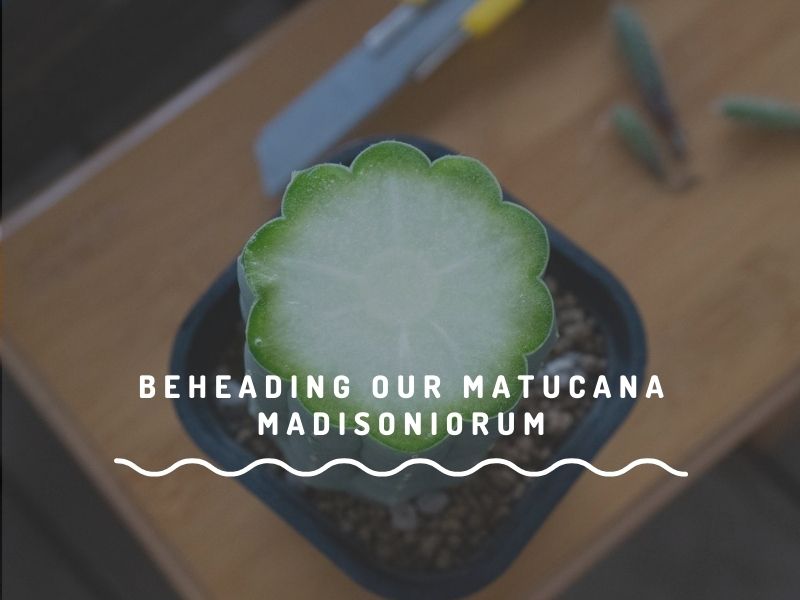We started a small project this weekend to slice the head off our Matucana Madisoniorum. We first got it in March 2019 and on the right is how it looks right in July 2020. This is one of our first few cacti and we made a lot of mistakes growing it. Beheading it gives us a second chance to right our wrongs by growing it hard.
Why our Matucana etiolated
We scratched our heads to understand why the Matucana etiolated to this extent even though we gave it six hours of direct afternoon sun daily. At first, we thought the pot was too small so we re-potted into a deeper and wider pot. It continued to grow taller. Then, we suspected that it did not have enough nutrition so we watered and fertilized a little more. Little did we know that our actions actually fueled the cactus to grow even taller. When plants etiolate, the reason that usually comes to mind is due to a lack of light. However, one seasoned grower shared that cacti also etiolate when we over-water, over-fertilize and give too much sun when the roots are not yet established. It made a lot of sense as we also have other cactus that exhibited the same behaviour (growing tall without fattening up) when we directly pot them without roots in fully organic soil.
Growing cacti hard
Matucanas are found in the wild along slopes in canyons of the Río Marañón (Peru) [1] They grow on the dry ground hidden among the other vegetation. The region gets as little as 162mm [2] of rainfall annually. In comparison to where we live, we got around 233mm of rainfall in June 2020 alone. Unlike us, the grower grew his Matucana in conditions similar to how they are found in nature, using a media that is highly inorganic and watering only when the plant looks slightly shriveled. Because the Matucana is mainly made up of water (as you will see later), effectively, he watered it less than once a month.
Beheading cacti to regrow
It is too late for us to try to water our Matucana less as it has already grown into this columnar shape and will never go back to that cute globular ball. What we can do is try to start afresh by chopping off the growing parts (meristem) of the plant and try to root it.
First, we prepare our tools.
- A sharp and clean blade – I switch a new blade every time I’m cutting up my plants for grafting
- A sterilizer for the blade – I used Hydrogen Peroxide but Isopropyl Alcohol works too
A single cut splits the cacti into two. It does not have a woody stem like the Hylocereus Undatus (Dragon fruit) so its really easy for the blade to go through. Looking at the fleshly stem, you can now understand why the plant can survive weeks without water.
For the top part, we want to root it so that it can regrow. I dabbed it with a layer of rooting powder to help with the drying process and prevent fungus infection. Afterwhich I leave it with the wound facing upwards for a few days until it totally calluses over. Finally, I will flip it right side up to get it to root.
For the lower part, I could leave it and see if it will pup from the areoles (the white spots where the flowers grow from). However, I decided to try my luck and graft a few seedlings along the main vessel. I chose some Harrisa Jusbertii babies from my seedling tray and quickly stuck them on.
That’s all for our weekend project. Excited to see how this will turn out.
Update – 1 August 2020
The wound looks like it is callousing over. There doesn’t seem to be any rotting areas. I left it facing down on some slightly wet stones so that the darkness can induce some roots. I used Kanuma since we have it already prepared as a spot to root plants. The grafts doesn’t seem to be moving but also doesn’t seem to be dying so I take that as a win. Will have to check back the photos in the future to see if there is any growth at all.
[1] http://www.society.bcss.org.uk/index.php/taking-part/branches/branches-list/92-spalding.html
[2] https://en.wikipedia.org/wiki/Mara%C3%B1%C3%B3n_dry_forests

